Junke Wang
TempoMaster: Efficient Long Video Generation via Next-Frame-Rate Prediction
Nov 16, 2025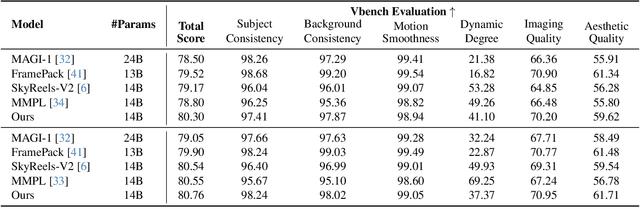

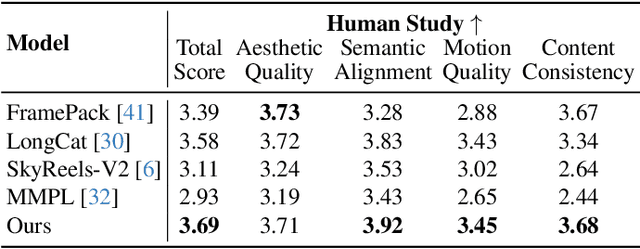
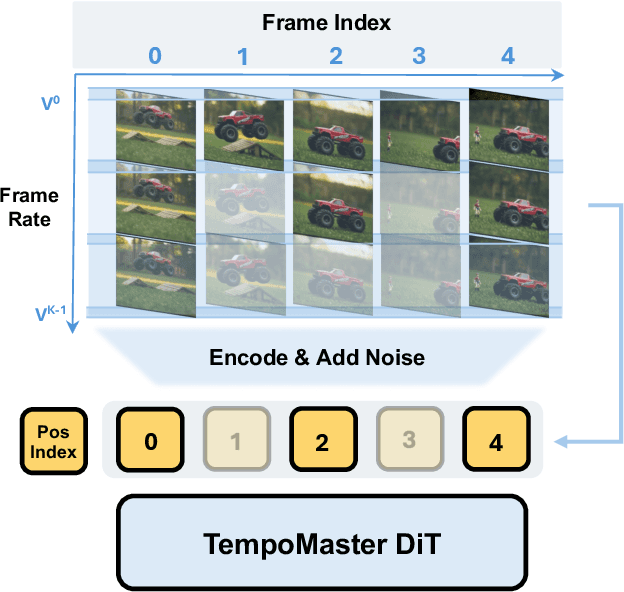
Abstract:We present TempoMaster, a novel framework that formulates long video generation as next-frame-rate prediction. Specifically, we first generate a low-frame-rate clip that serves as a coarse blueprint of the entire video sequence, and then progressively increase the frame rate to refine visual details and motion continuity. During generation, TempoMaster employs bidirectional attention within each frame-rate level while performing autoregression across frame rates, thus achieving long-range temporal coherence while enabling efficient and parallel synthesis. Extensive experiments demonstrate that TempoMaster establishes a new state-of-the-art in long video generation, excelling in both visual and temporal quality.
Rethinking Discrete Tokens: Treating Them as Conditions for Continuous Autoregressive Image Synthesis
Jul 02, 2025Abstract:Recent advances in large language models (LLMs) have spurred interests in encoding images as discrete tokens and leveraging autoregressive (AR) frameworks for visual generation. However, the quantization process in AR-based visual generation models inherently introduces information loss that degrades image fidelity. To mitigate this limitation, recent studies have explored to autoregressively predict continuous tokens. Unlike discrete tokens that reside in a structured and bounded space, continuous representations exist in an unbounded, high-dimensional space, making density estimation more challenging and increasing the risk of generating out-of-distribution artifacts. Based on the above findings, this work introduces DisCon (Discrete-Conditioned Continuous Autoregressive Model), a novel framework that reinterprets discrete tokens as conditional signals rather than generation targets. By modeling the conditional probability of continuous representations conditioned on discrete tokens, DisCon circumvents the optimization challenges of continuous token modeling while avoiding the information loss caused by quantization. DisCon achieves a gFID score of 1.38 on ImageNet 256$\times$256 generation, outperforming state-of-the-art autoregressive approaches by a clear margin.
CKD-EHR:Clinical Knowledge Distillation for Electronic Health Records
Jun 18, 2025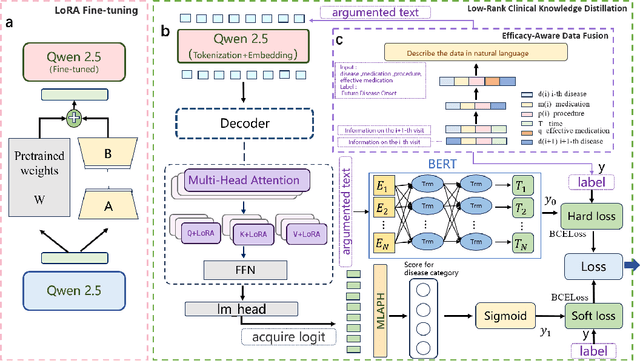
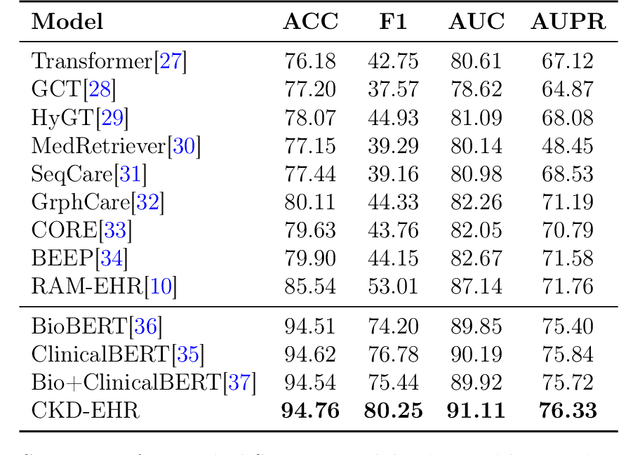

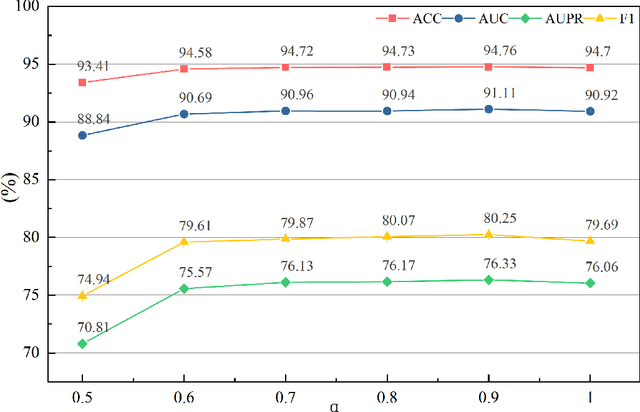
Abstract:Electronic Health Records (EHR)-based disease prediction models have demonstrated significant clinical value in promoting precision medicine and enabling early intervention. However, existing large language models face two major challenges: insufficient representation of medical knowledge and low efficiency in clinical deployment. To address these challenges, this study proposes the CKD-EHR (Clinical Knowledge Distillation for EHR) framework, which achieves efficient and accurate disease risk prediction through knowledge distillation techniques. Specifically, the large language model Qwen2.5-7B is first fine-tuned on medical knowledge-enhanced data to serve as the teacher model.It then generates interpretable soft labels through a multi-granularity attention distillation mechanism. Finally, the distilled knowledge is transferred to a lightweight BERT student model. Experimental results show that on the MIMIC-III dataset, CKD-EHR significantly outperforms the baseline model:diagnostic accuracy is increased by 9%, F1-score is improved by 27%, and a 22.2 times inference speedup is achieved. This innovative solution not only greatly improves resource utilization efficiency but also significantly enhances the accuracy and timeliness of diagnosis, providing a practical technical approach for resource optimization in clinical settings. The code and data for this research are available athttps://github.com/209506702/CKD_EHR.
Perception Encoder: The best visual embeddings are not at the output of the network
Apr 17, 2025

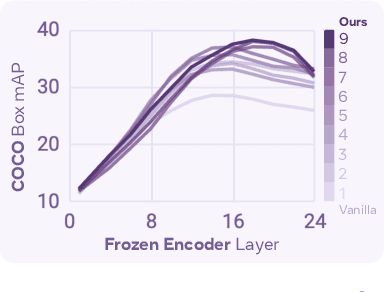
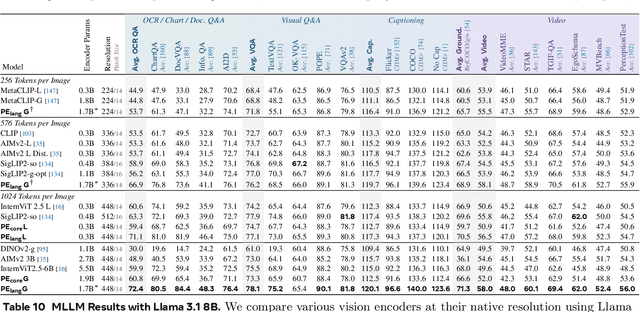
Abstract:We introduce Perception Encoder (PE), a state-of-the-art encoder for image and video understanding trained via simple vision-language learning. Traditionally, vision encoders have relied on a variety of pretraining objectives, each tailored to specific downstream tasks such as classification, captioning, or localization. Surprisingly, after scaling our carefully tuned image pretraining recipe and refining with our robust video data engine, we find that contrastive vision-language training alone can produce strong, general embeddings for all of these downstream tasks. There is only one caveat: these embeddings are hidden within the intermediate layers of the network. To draw them out, we introduce two alignment methods, language alignment for multimodal language modeling, and spatial alignment for dense prediction. Together with the core contrastive checkpoint, our PE family of models achieves state-of-the-art performance on a wide variety of tasks, including zero-shot image and video classification and retrieval; document, image, and video Q&A; and spatial tasks such as detection, depth estimation, and tracking. To foster further research, we are releasing our models, code, and a novel dataset of synthetically and human-annotated videos.
SimpleAR: Pushing the Frontier of Autoregressive Visual Generation through Pretraining, SFT, and RL
Apr 15, 2025Abstract:This work presents SimpleAR, a vanilla autoregressive visual generation framework without complex architecure modifications. Through careful exploration of training and inference optimization, we demonstrate that: 1) with only 0.5B parameters, our model can generate 1024x1024 resolution images with high fidelity, and achieve competitive results on challenging text-to-image benchmarks, e.g., 0.59 on GenEval and 79.66 on DPG; 2) both supervised fine-tuning (SFT) and Group Relative Policy Optimization (GRPO) training could lead to significant improvements on generation aesthectics and prompt alignment; and 3) when optimized with inference acceleraton techniques like vLLM, the time for SimpleAR to generate an 1024x1024 image could be reduced to around 14 seconds. By sharing these findings and open-sourcing the code, we hope to reveal the potential of autoregressive visual generation and encourage more participation in this research field. Code is available at https://github.com/wdrink/SimpleAR.
Pix2Cap-COCO: Advancing Visual Comprehension via Pixel-Level Captioning
Jan 23, 2025


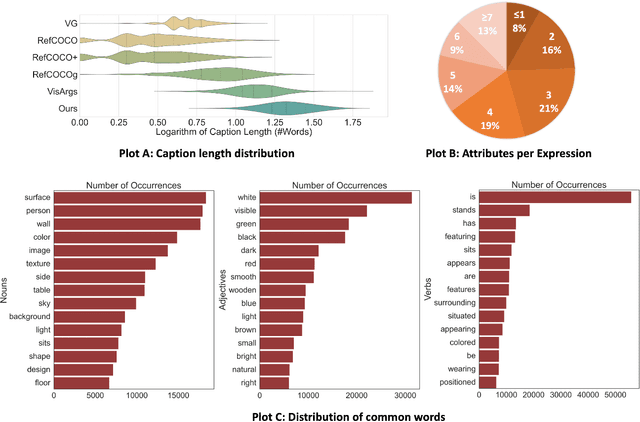
Abstract:We present Pix2Cap-COCO, the first panoptic pixel-level caption dataset designed to advance fine-grained visual understanding. To achieve this, we carefully design an automated annotation pipeline that prompts GPT-4V to generate pixel-aligned, instance-specific captions for individual objects within images, enabling models to learn more granular relationships between objects and their contexts. This approach results in 167,254 detailed captions, with an average of 22.94 words per caption. Building on Pix2Cap-COCO, we introduce a novel task, panoptic segmentation-captioning, which challenges models to recognize instances in an image and provide detailed descriptions for each simultaneously. To benchmark this task, we design a robust baseline based on X-Decoder. The experimental results demonstrate that Pix2Cap-COCO is a particularly challenging dataset, as it requires models to excel in both fine-grained visual understanding and detailed language generation. Furthermore, we leverage Pix2Cap-COCO for Supervised Fine-Tuning (SFT) on large multimodal models (LMMs) to enhance their performance. For example, training with Pix2Cap-COCO significantly improves the performance of GPT4RoI, yielding gains in CIDEr +1.4%, ROUGE +0.4%, and SPICE +0.5% on Visual Genome dataset, and strengthens its region understanding ability on the ViP-BENCH, with an overall improvement of +5.1%, including notable increases in recognition accuracy +11.2% and language generation quality +22.2%.
OmniTokenizer: A Joint Image-Video Tokenizer for Visual Generation
Jun 13, 2024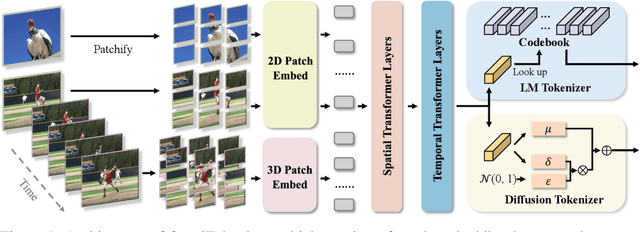
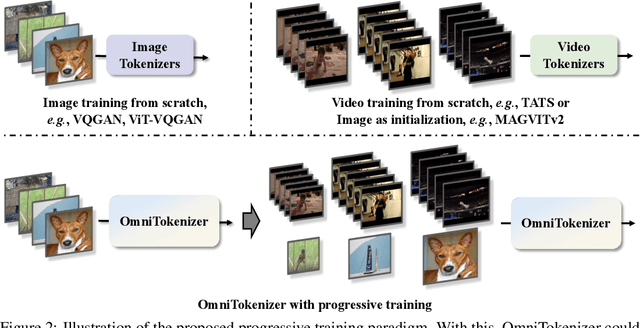
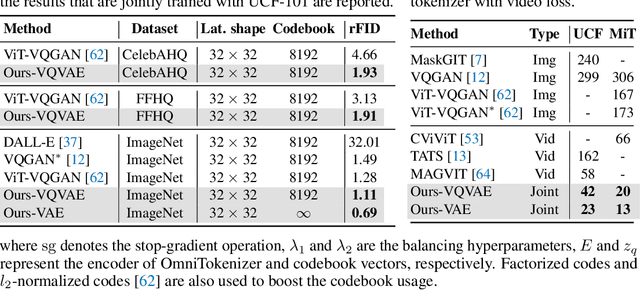
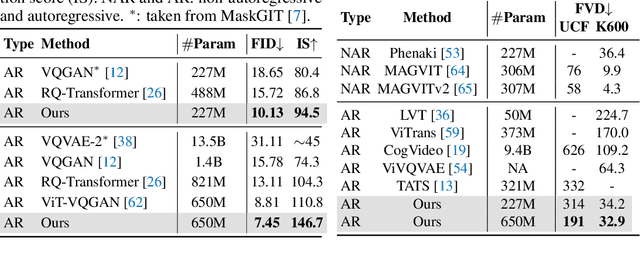
Abstract:Tokenizer, serving as a translator to map the intricate visual data into a compact latent space, lies at the core of visual generative models. Based on the finding that existing tokenizers are tailored to image or video inputs, this paper presents OmniTokenizer, a transformer-based tokenizer for joint image and video tokenization. OmniTokenizer is designed with a spatial-temporal decoupled architecture, which integrates window and causal attention for spatial and temporal modeling. To exploit the complementary nature of image and video data, we further propose a progressive training strategy, where OmniTokenizer is first trained on image data on a fixed resolution to develop the spatial encoding capacity and then jointly trained on image and video data on multiple resolutions to learn the temporal dynamics. OmniTokenizer, for the first time, handles both image and video inputs within a unified framework and proves the possibility of realizing their synergy. Extensive experiments demonstrate that OmniTokenizer achieves state-of-the-art (SOTA) reconstruction performance on various image and video datasets, e.g., 1.11 reconstruction FID on ImageNet and 42 reconstruction FVD on UCF-101, beating the previous SOTA methods by 13% and 26%, respectively. Additionally, we also show that when integrated with OmniTokenizer, both language model-based approaches and diffusion models can realize advanced visual synthesis performance, underscoring the superiority and versatility of our method. Code is available at https://github.com/FoundationVision/OmniTokenizer.
OmniVid: A Generative Framework for Universal Video Understanding
Mar 26, 2024



Abstract:The core of video understanding tasks, such as recognition, captioning, and tracking, is to automatically detect objects or actions in a video and analyze their temporal evolution. Despite sharing a common goal, different tasks often rely on distinct model architectures and annotation formats. In contrast, natural language processing benefits from a unified output space, i.e., text sequences, which simplifies the training of powerful foundational language models, such as GPT-3, with extensive training corpora. Inspired by this, we seek to unify the output space of video understanding tasks by using languages as labels and additionally introducing time and box tokens. In this way, a variety of video tasks could be formulated as video-grounded token generation. This enables us to address various types of video tasks, including classification (such as action recognition), captioning (covering clip captioning, video question answering, and dense video captioning), and localization tasks (such as visual object tracking) within a fully shared encoder-decoder architecture, following a generative framework. Through comprehensive experiments, we demonstrate such a simple and straightforward idea is quite effective and can achieve state-of-the-art or competitive results on seven video benchmarks, providing a novel perspective for more universal video understanding. Code is available at https://github.com/wangjk666/OmniVid.
MouSi: Poly-Visual-Expert Vision-Language Models
Jan 30, 2024Abstract:Current large vision-language models (VLMs) often encounter challenges such as insufficient capabilities of a single visual component and excessively long visual tokens. These issues can limit the model's effectiveness in accurately interpreting complex visual information and over-lengthy contextual information. Addressing these challenges is crucial for enhancing the performance and applicability of VLMs. This paper proposes the use of ensemble experts technique to synergizes the capabilities of individual visual encoders, including those skilled in image-text matching, OCR, image segmentation, etc. This technique introduces a fusion network to unify the processing of outputs from different visual experts, while bridging the gap between image encoders and pre-trained LLMs. In addition, we explore different positional encoding schemes to alleviate the waste of positional encoding caused by lengthy image feature sequences, effectively addressing the issue of position overflow and length limitations. For instance, in our implementation, this technique significantly reduces the positional occupancy in models like SAM, from a substantial 4096 to a more efficient and manageable 64 or even down to 1. Experimental results demonstrate that VLMs with multiple experts exhibit consistently superior performance over isolated visual encoders and mark a significant performance boost as more experts are integrated. We have open-sourced the training code used in this report. All of these resources can be found on our project website.
To See is to Believe: Prompting GPT-4V for Better Visual Instruction Tuning
Nov 29, 2023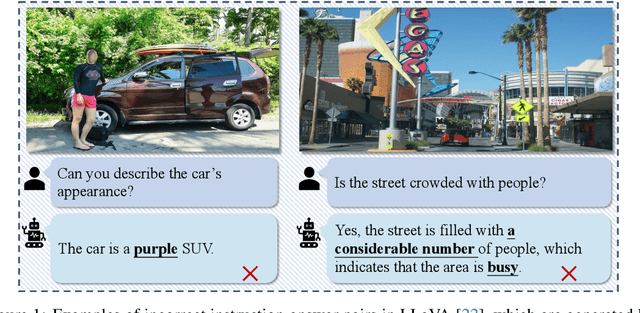
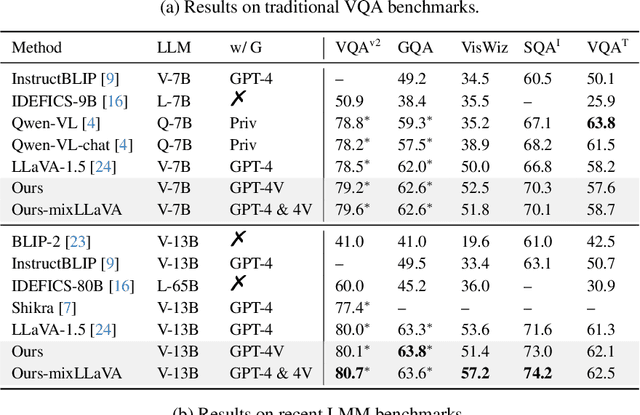
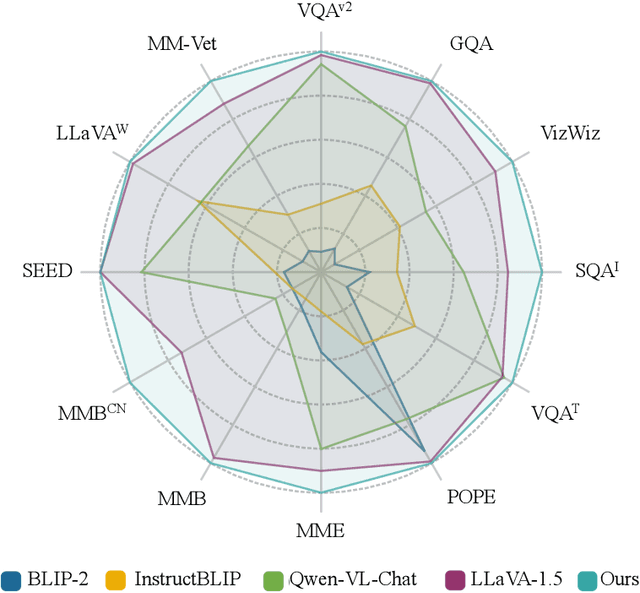

Abstract:Existing visual instruction tuning methods typically prompt large language models with textual descriptions to generate instruction-following data. Despite the promising performance achieved, these descriptions are derived from image annotations, which are oftentimes coarse-grained. Furthermore, the instructions might even contradict the visual content without observing the entire visual context. To address this challenge, we introduce a fine-grained visual instruction dataset, LVIS-Instruct4V, which contains 220K visually aligned and context-aware instructions produced by prompting the powerful GPT-4V with images from LVIS. Through experimental validation and case studies, we demonstrate that high-quality visual instructional data could improve the performance of LLaVA-1.5, a state-of-the-art large multimodal model, across a wide spectrum of benchmarks by clear margins. Notably, by simply replacing the LLaVA-Instruct with our LVIS-Instruct4V, we achieve better results than LLaVA on most challenging LMM benchmarks, e.g., LLaVA$^w$ (76.7 vs. 70.7) and MM-Vet (40.2 vs. 35.4). We release our data and model at https://github.com/X2FD/LVIS-INSTRUCT4V.
 Add to Chrome
Add to Chrome Add to Firefox
Add to Firefox Add to Edge
Add to Edge